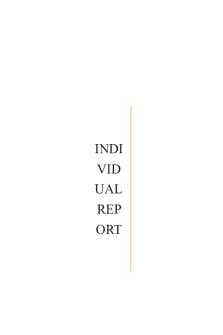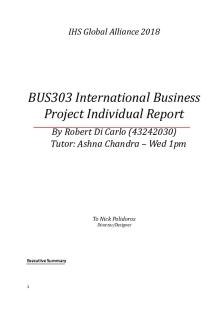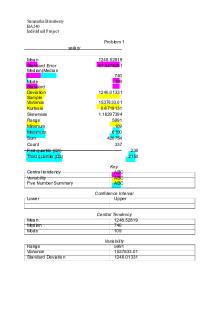Individual Group Report PDF

| Title | Individual Group Report |
|---|---|
| Course | International Business Strategy |
| Institution | Glasgow Caledonian University |
| Pages | 10 |
| File Size | 285.2 KB |
| File Type | |
| Total Downloads | 90 |
| Total Views | 127 |
Summary
Individual Group Report...
Description
International Business Strategy – M3N222479
Student Name: Matthew Grady Matriculation Number: S1114976 Seminar day and time: Wednesday, 10am Seminar Tutor name: Colin Combe Turnitin Score: 15% similarity Word count: 1,708
“The piece of coursework that I am submitting for International Business Strategy [M3N222479] is my original work, and has not been submitted elsewhere in fulfilment of the requirement of this or any other award”.
Individual Report - structured into the following sections: Contents Page Section One – Implementation of Strategy Section Two – Evaluation of Firm’s Strategy Section Three – Evaluation of Team and Self References
Content Implementation of strategy...................................................................................................................3 Evaluation of Firms Strategy..................................................................................................................5 Evaluation of Teams Strategy.................................................................................................................8 References...........................................................................................................................................10
Implementation of strategy
Corporate Social Responsibility(CSR) can be defined as ‘a business approach that contributes to sustainable development by delivering economic, social and environmental benefits for all stakeholders.’ (Webb, 2016) In today’s global market place, organisations must incorporate a CSR strategy at the core of their practices. Changing attitudes from Consumers and stakeholders means sustainability is a key issue (Aspen, 2008). If an organisation implements a CSR strategy, it ensures all stakeholders needs are considered. Meaning, the organisation is able to gain an advantage over competitors. However, CSR must be adopted into all practices of the business. If an organisation is using CSR for a public image boost, the rewards will be short term. A strong CSR culture can make an organisation forward thinking and adaptive, and truly sustainable. Employees will feel empowered and consumers know that they are making the right choice. In recent years, there has been negative effects for companies who do not operate in a socially responsible way. For example, the motoring manufacturer, Volkswagen AG, has recently had a CSR failure. (Dans, 2015) The company deceived consumers with its cars emission figures. They are now facing a public image crisis as well as recalls, law suits and the company’s share price plummeted as further details about the scale of the scandal emerged. In an attempt to recover from the crisis, Volkswagen has changed its CSR policy and has adopted it to the core of its practices. The organisation is now the leading the auto-industry in its efforts to become greener and have a greater legacy for its stakeholders.(Volkswagen, 2015) Therefore it can be said that without appropriate CSR culture and adaptation an organisation will be worse off financially and their public image will suffer. Discussing the Economics needs of the organisation, it can be said that traditionally a business must make a profit, if it is to continue with any other goals it aims to achieve. However, many modern business’ have adapted this theory to include the idea that a business can make profit whilst doing good. Many modern organisations are adopting the business model of social enterprise. (Abu-saifan, 2012) A social enterprise is an organisation that operates with the purpose of improving the lives of communities and the environment around them through entrepreneurial activity. Government statistics identify that there are around 70,000 social enterprises in the UK, which are contributing £24 billion to the economy and employing nearly a million people. (Villeneuve-Smith and Temple, 2015) This number is growing and it demonstrates that CSR and social enterprise is going to lead the way in which many organisations operate. During the Business Simulation exercise, our company, ‘Peak Fitness’, created in a small-scale CSR scheme. We developed and introduced a “Cycle to School Scheme”. The scheme offered children from the ages of 5-11 the chance to have a free bike to cycle to school on. The idea, was created as a way to spend excess profits and give back to the local community around our business. The project was designed empower children to keep active and healthy by riding bicycles, otherwise they might not be able to afford them.
This scheme was an example that many real-life organisations follow. Our organisation was using CSR as an opportunity to demonstrate the ethical values of the organisation, whilst gaining good publicity. Therefore, it can be said that the benefit to the community was not entirely the strategy. The project was an example of an organisation following a short term view of CSR. This example
helps highlight the issue that CSR needs to be a long term vision, at the core of the organisations beliefs. In summary, CSR is an ever growing important aspect of modern business. Organisations no longer can chase profit without respect for its stakeholders or the environment in which it operates. If CSR fails, it can have dire consequences for an organisation. However, if CSR is truly at the core, it can be said that an organisation is at an advantage to competition and can sustain itself in the future.
Evaluation of Firms Strategy During our seminar class, we assessed the performance of the organisation. The data from highlighted the organisation was running at a loss. We needed to make changes to increase the profit
margin, and increase sales of the existing products. Using the Ansoff model (Ansoff, 1957), we identified Market development as our core strategy. We decided it was important to establish ourselves within an existing market and expand our market share through quality products, and steady profit growth. With our core strategy established, we changed to the Highest Quality supplier available, Schneider GmbH. [ CITATION Edu17 \l 2057 ] This change ensured that we were increasing market share through product differentiation. As evidenced below, our decision to change supplier helped contribute to a positive change in our Market Share index.
1.1 – Our Decision to Choose Schneider GmbH.
1.2 – Our Year 1 Market Share Index.
1.3 – Our Year 5 Market Share Index. Comparing 1.2 to 1.3, it can be said our strategy has been effective in increasing our market share. However, it would not be an accurate evaluation to say that the change in supplier was the sole contributor to our increase in market share. Increased spending on market research, and marketing also contributed to the increase in market share. [ CITATION Edu17 \l 2057 ] Furthermore, Schneider GmbH was the most expensive supplier, we needed to ensure our profit loss margin was not decreasing. We therefore needed to consider the effects our strategy, increasing the market share, would have on other score indicators. In order to achieve a well-balanced scorecard, we needed to ensure our
high quality products were making a profit, and that our staff were happy [ CITATION Edu17 \l 2057 ].
1.4 – Our Year 1 Profit Indicator
1.5 Our Year 5 Profit Indicator It is clear that were able to increase profits through our strategy, and our profits did not suffer as a result of our decision to choose a more expensive supplier.
1.6 – Our Year 1 Staff Loyalty Scorecard
1.7 – Our year 7 Staff Loyalty Scorecard Comparing 1.6 to 1.7 It can be said that there is a significant increase in staff Loyalty.
Therefore, I would evaluate we implemented a good strategy. Our decision to choose Higher quality suppliers benefited our market share and also our decision to increase spending on research and staff development ensured that our employees were significantly happier working for the organisation. Were able to place inside the top 10 for the game [ CITATION Edu17 \l 2057 ], a result we were very happy with.
Evaluation of Teams Strategy Leading up to the game, our team discussed strengths and weaknesses to understand each person’s ability. Using Belbin’s team roles as framework [ CITATION Bel96 \l 2057 ] , we allocated tasks to each member based upon their preferred role. My personal contribution, was to work out if the decisions we were making would allow the profit to grow. As a shaper and co-ordinator, I analysed the data from the game and delegated task based upon my financial calculations. For example, we based our stock order quantities and selling prices from these calculations. Our whole team was involved in the decision making process, and this was very effective in creating a strong team that worked hard to achieve the goals we had set. It can be said that we followed Tuckman’s model of group development [ CITATION Tuc65 \l 2057 ] , and very quickly we reached the ‘performing’ stage. Each team member was effective in their role, and contributed to a task without interference. For example, I would contribute financial calculations, whilst other team members would make marketing, and research and development decisions independently of each other. As a team we held a weekly meeting, where we would contribute our decisions. This framework was effective in making sure we were ahead of the competition, and that all decisions were made on time. In previous group tasks at university I have faced problems of people not contributing or turning up, I have also faced team members falling out and there being an atmosphere of hostility. I can categorically say that it was this was not the case, and that it was pleasure to be involved in this team. I believe everyone contributed 100% and therefore I would not change anything with the team working process. We were effective in achieving our goals, and were able to have fun whilst learning. In the peer assessment process, we were faced with the difficult task of deciding who had contributed what. As we often made the decisions together it was hard to differentiate each team member’s individual contribution. Therefore, the peer assessment was centred around what work each team member had done outside of the regular meetings. It was clear that we had all evenly contributed and therefore decided that we were each to receive 100% of the allocated marks. Through working in the team I was able to develop my financial analysis skills. I was able to take financial data, and manipulate it to assist decisions made in the game. I believe I was able to grow confident in my own personal ability to analyse data. I was also able to develop communication skills and present my calculations at each weekly meeting to the team. This will help me beyond university, as I will be required to do such tasks as a summer intern at a financial advisory firm. Using Maslow’s Hierarchy of needs growth [ CITATION Mas43 \l 2057 ] I believe I was able to fulfil psychological and self-fulfilment needs, I found the tasks to be rewarding. Each week, when the trading results were in, I would get a sense of achievement depending on how successful we had been. Furthermore, by creating financial analysis without assistance I was able to experience selffulfilment. I thoroughly enjoyed the game environment as it brought out my competitive side, I have learned this is something that drives me to work harder.
Personally, I learned that I was strong at working with financial data and I was able to take charge in any task I was doing. I found, however, I would struggle to ask for help, and would aim to complete my tasks independently. I believe this is a result of me setting high standards for myself. Therefore, I
have learned that in future University tasks I must be willing to let others contribute, if I am struggling.
References Abu-Saifan, 2012 Technology Innovation Management Review February 2012 www.timreview.ca 22 Social Entrepreneurship: Definition and Boundaries Samer Abu-Saifan pp. 23-24 Aspen Institute, (2008). Student Attitudes Survey. http://www.aspencbe. org/documents/ExecutiveSummaryMBAStudentAttitudesReport2008.pdf Belbin, 1996. The coming shape of organization. Oxford: Butterworth-Heinemann. Carroll, A.B. (1979). A Three Dimensional Conceptual Model of Corporate Social Performance. Academy of Management Review, 4, pp.497-505. Dans, 2015. Forbes.com. N.p., 2017. Web. 10 Jan. 2017. Available at: http://www.forbes.com/sites/enriquedans/2015/09/27/volkswagen-and-the-failure-of-corporate-socialresponsibility/#67f97c8a6128 Edumundo, 2017. Edumundo Game. [Online] Available at: http://game.edumundo.co.uk/Login.aspx? ReturnUrl=%2fdefault.aspx%3fid%3d1915&id=1915 Maslow, 1943. The Theory of Human Motivation. Psychological Review, 50(4), pp. 370-396. Tuckman, B., 1965. Developmental Sequence in Small Groups. Psycological Bulletin, Volume 63, pp. 384-399. Webb, J., 2016. The Shared Value of Corporate Social Responsibility. The Financial Times, 11 February. Volkswagen, 2015. Volkswagenag.com. N.p., 2017. Available at: https://www.volkswagenag.com/en/group/strategy.html Villeneuve-Smith and Temple, 2015 State of Social Enterprise Survey 2015 Available at: http://socialenterprise.org.uk/uploads/editor/files/Publications/FINALVERSIONStateofSocialEnterpriseReport2 015.pdf...
Similar Free PDFs

Individual Group Report
- 10 Pages

Individual Report
- 14 Pages

Group Report
- 26 Pages

Group Report on Partex Group
- 29 Pages

ACCG1001 Individual Report
- 6 Pages

BUS303 Individual Project Report
- 23 Pages

Individual Report- Edumondo
- 7 Pages

Report - Assignment 2 : Individual
- 11 Pages

BA240 Individual Report Brimb
- 6 Pages

Individual Report Walmart
- 7 Pages

Individual Report - 2
- 3 Pages

Individual Report - Marketing Audit
- 20 Pages

Individual Market View Report
- 7 Pages

Report Vbiz3 Group 1
- 13 Pages
Popular Institutions
- Tinajero National High School - Annex
- Politeknik Caltex Riau
- Yokohama City University
- SGT University
- University of Al-Qadisiyah
- Divine Word College of Vigan
- Techniek College Rotterdam
- Universidade de Santiago
- Universiti Teknologi MARA Cawangan Johor Kampus Pasir Gudang
- Poltekkes Kemenkes Yogyakarta
- Baguio City National High School
- Colegio san marcos
- preparatoria uno
- Centro de Bachillerato Tecnológico Industrial y de Servicios No. 107
- Dalian Maritime University
- Quang Trung Secondary School
- Colegio Tecnológico en Informática
- Corporación Regional de Educación Superior
- Grupo CEDVA
- Dar Al Uloom University
- Centro de Estudios Preuniversitarios de la Universidad Nacional de Ingeniería
- 上智大学
- Aakash International School, Nuna Majara
- San Felipe Neri Catholic School
- Kang Chiao International School - New Taipei City
- Misamis Occidental National High School
- Institución Educativa Escuela Normal Juan Ladrilleros
- Kolehiyo ng Pantukan
- Batanes State College
- Instituto Continental
- Sekolah Menengah Kejuruan Kesehatan Kaltara (Tarakan)
- Colegio de La Inmaculada Concepcion - Cebu

